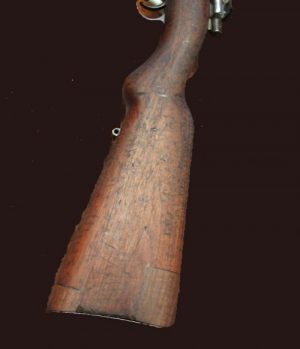
Scratches and gouges can be repaired in one of two ways, or a combination of both. If the color of the wood must not be cut through by sanding, the missing wood must be replaced by filling. Extremely large work will require inletting well-matched wood — perhaps, wood borrowed from inside a barrel groove. For the usual filling of reasonably sized repairs, a mixture of wood dust and a clear adhesive cement will serve nicely. Preferably, the wood dust should come from the stock itself. If the stock is a stained one, the chances are that the wood normally covered by butt-plate, pistol-grip and such fittings was also stained at the same time. The small amount of wood needed may be scraped from such areas and will not show removal when the arm is reassembled. If such areas are not available, there may be others available; for instance, the mid-point of a barrel groove (if not oil-soaked) where removal of a sanded amount will not affect the barrel bedding. The obtained dust should be mixed with clear cement so that it is a thoroughly permeated, mealy paste. It should be applied in more than one layer. with dry between the layers, if the depth of the hole exceeds perhaps a sixteenth of an inch and, as the patching material will shrink during dry, should be built up just a little higher than the surrounding wood. Then, when dry, it can be sanded down to level. Some holes will fill more securely if their walls are cut out to a vertical square with the surface. Some even slightly undercut, if wished, and the bottoms scored for best adhesion. All cavities should be cleaned with Naphtha before filling, so as to give maximum adhesion.
The other method of removing scratches and gouges is by sanding them out. As with all sanding of complete stocks, great care must be taken not to sand enough along inletted or fitted edges to change and damage the fit of the parts when the gun is reassembled. It is important not to leave sanded hollows that will be emphasized later by the final finish. A suitably sized block of wood or foam used to wrap the sandpaper around will help prevent such unsightly hollows. Ordinarily sanding should be carried well beyond the area of actual repair. For instance, sanding a gouge out of the flat of a butt-stock may well require a diminishing change of shape all the way to the grip area and not only all the way to the rear in the other direction but also, perhaps, even a slight change in the shape of the butt-plate or pad. Many scratches are not sanded just quite enough. This is a case of stopping just short of perfection and is typical of all sanding operations. The bottom of many a scratch is actually a dent combined with the scratch. If the dent-raising technique, discussed earlier, is applied initially to all such damage, the situation can be improved in a routine manner. Final sanding of a repaired stock should be limited to the finest grit paper that w ill do the job. There is no point in having to sand out scratches left by needlessly coarse papers. Perhaps #600 is too fine, but #280 should usually serve before the #600 paper finalizes the preparation for finishing. Such wet-or-dry papers can be used dry or, as a lubricant. ordinary Linseed Oil can be used in moderation. Such an oil must not be used in profusion or it will soak into the wood and possibly cause a slow, or even unsatisfactory, dry of the finish.
